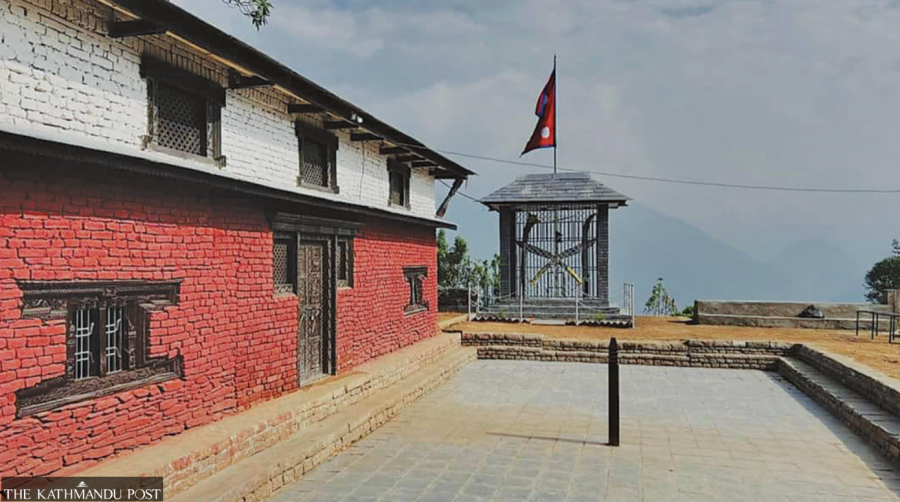Money
Kot Ghar restored and preserved to draw tourists
Galkot once served as the fortress of the hilly kingdom ruled by the Mallas.
Prakash Baral
Kot Ghar, once considered the seat of powerful Malla kings of Galkot, a pretty kingdom in the confederation of 24 states known as Chaubisi Rajya, has been restored and preserved to draw tourists.
The Kot Ghar means a house where weapons are placed or stored.
The town of Galkot once served as the fortress of the hilly kingdom ruled by the Mallas. The historical palace, which has been renovated, offers a reason to visit Galkot.
Before the Panchayat era, Galkot served as Baglung's headquarters. Without the administrative offices, the locals seek to make Galkot the tourism headquarters of Baglung.
According to history, Jitari Malla, the elder son of King Narayan Malla of Parbat, established Galkot Rajya in 1631 BS.
A stone inscription states that Kot Ghar was constructed in 1661 BS. Galkot was free until Jagat Pratap Malla's rule in 1844 BS.
The local government has been trying to preserve the historical artefacts to showcase to the visitors. The ancient palace of Galkot was in dire straits because of the lack of conservation.
The Shreemeher Gana barracks of the Nepal Army and Galkot municipality have jointly renovated the almost-collapsed Kot Ghar.
Professor Din Bahadur Thapa, a historian, said that the state also produced rice during the 10th generation of kings 213 years ago.
After that, until 2015 BS, the kings of Galkot remained rulers. After the last king, Bharat Bam Malla, was elected to parliament in the 2015 BS general election, Raja Rajouta stepped down.
There is a history of Bharat Bam submitting a proposal to remove Raja Rajauta from the House of Representatives.
Thapa's research mentions that the state of Galkot extended to Kathekhola in the east, Pandavakhani in the west, Rum in Myagdi in the north, and Musikot in Gulmi in the south.
After the kingdom was taken away, Jagat Pratap Bam Malla moved the palace to Shraddhakhet. The last king, Bharat Bam, built a palace in Harichor Bazar in 1990 BS. The construction started in 1978 BS.
Even until 2019 BS, the central administrative units of Baglung were in Galkot. Later, they were shifted to Baglung Bazaar. The Kot Ghar conservation and tourism promotion programme was started five years ago to reflect this legacy.
Bir Jung Bhandari, former ward chairman of Galkot Municipality, had started some of the works.
Bharat Sharma Gaire, mayor of the municipality, said that the historic city planning and the work to preserve the history had been completed with the help of the Nepal Army.
Cannoning infrastructure has also been built at Sahasradhara waterfall near Kot Ghar. Festivals are organised during the Dashain and Chaite Dashain. Hundreds of pilgrims tour these religious sites annually.
Locals conduct regular worship. A hundred houses in Kotmaidan village offer worship by taking ownership. It is listed in the city pride project.
The weapons in Kot Ghar have been kept separately by making a new home. The doors and windows of Kot Ghar have been modelled on the Bhaktapur craft. On the way to Kot Ghar, a barbed wire fence and railing have been set up.
Drainage and culverts have been constructed in some road stretches that reach Kot Ghar from the mid-hill highway. The municipality has been investing yearly to pave the road to Kot Ghar. The location is important from the tourism perspective.
Galkot Valley, Ghumte hill, Daram River, and Tara River can be viewed from Kot Ghar. Kalika temple, near Kot Ghar, has also been maintained.
Nearly 100 ropanies have been protected through barbed wire fences. The number of tourists visiting Kot Ghar has recently increased with the construction of drinking water taps and resting areas.
The association of the former army conducted a district-level annual general meeting in the Kot Ghar area.
It is presumed that the state was named Galkot, derived from ‘Golo Kot’, the way the Kot Ghar was built.
Kot Ghar, located in Galkot Municipality-3, was the first seat of the kings. Though the king shifted to Harichaur through Shraddakhet, the weapons were kept in Kot Ghar and Kalika temple.
Other structures were also built around Kot Ghar. Gaire said the places of historical importance were protected. A six-kilometre road has been built from the mid-hill highway to Kot Ghar.
The road to Kot Ghar from the highway was maintained and paved, said Pham Bahadur Khatri, the ward chairman. He said that around Rs1.5 million was spent to renovate Kot Ghar, and the Nepal Army provided Rs900,000 and the human resources.




 8.12°C Kathmandu
8.12°C Kathmandu.jpg)















